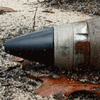Introduction to Ordnance Fuzes
The purpose of a fuze is to provide safe separation of a weapon from the delivery platform and reliable detonation at the desired time delay upon weapon actuation. Safe separation is provided by the "fuze arming time". This is the preset amount of time required for a weapon to arm once it is released and is usually measured in seconds.
Reliable detonation at the desired time delay is provided by the "function delay time". This is the preset amount of time at which the weapon will detonate after it has been triggered. There are usually several options for functional delays including:
- Proximity: Fuzes that sense the weapon.s proximity to the ground or an object like a plane or tank and that triggers weapon detonation prior to impact. These fuzes are extremely useful against enemy troops in the open, against soft-skinned vehicles or planes.
- Instantaneous: Fuzes that will attempt to detonate immediately upon impact.
- Delay: Fuzes are designed to detonate at some finite amount of time after impact. Useful for penetrating hardened targets, ships, or buildings. Time delay is usually measured in milliseconds. May be hours or days in the case of mines or area denial weapons.
Fuzes are normally classified by their position in the weapon: nose or tail for bombs, internal for other munitions; by the arming mechanism; or method of functioning. There are thousands of different types of fuzes found in ordnance. Fuzes are often times grouped into families.
Common fuze families include the following:
|
|
| Ordnance Start Page | Ordnance Fuzing | Ordnance Photo Gallery |
| Ordnance Categories | Weapons Deployment | Ordnance Hazards |













